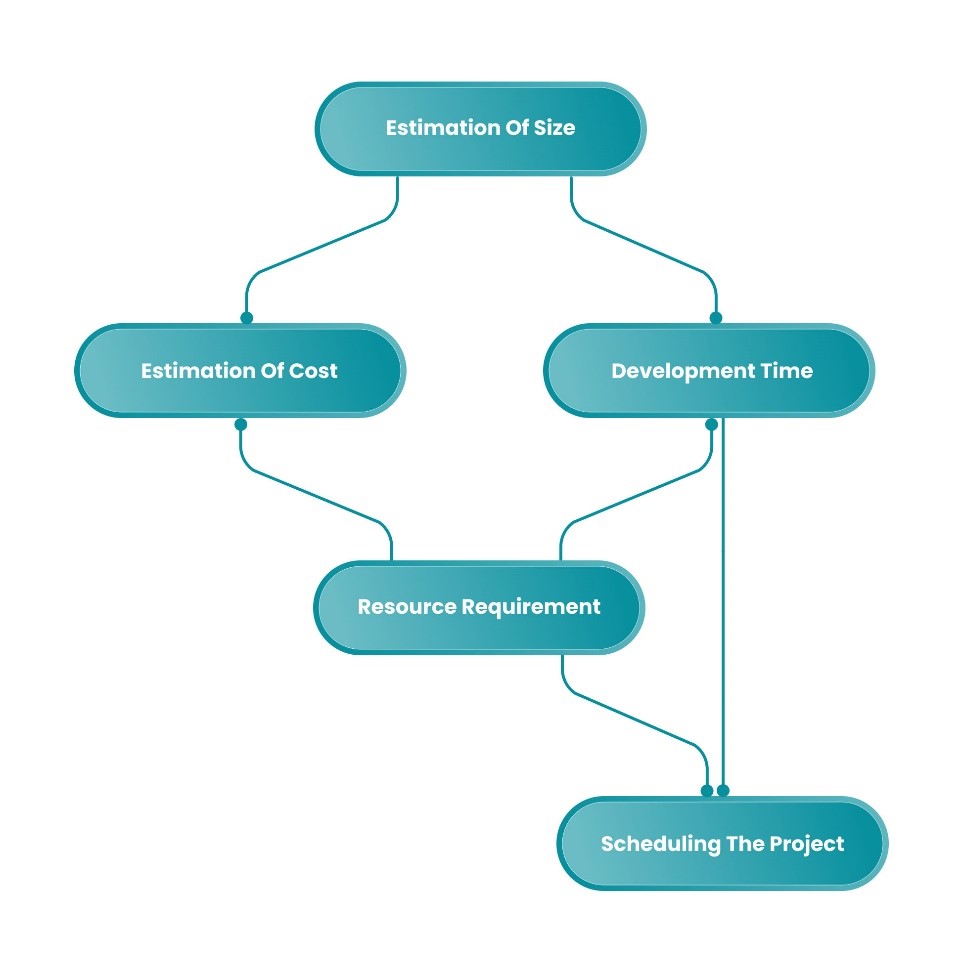A well-developed project plan follows a guideline. Ensure you have developed the guidelines in advance. Setting this guideline also ensures that the navigation path has been well-thought prior to developing the same. It thus increases the chance for the success of the project in advance.
Executing a smooth software development plan requires a well-defined objective and a purpose. You have to have your detailed requirements listed before commencing the project as it is needed to set the tone of the development.
The underrated significance of this phase can be understood with the fact that failing to plan for the project can fail the entire development. It is this planning phase that allows stakeholders, investors and team members to get onto the same page while understanding the scope, goal, potential risk, and timelines for schedules.
Why Software Project Plan is Important?
Software project planning acts as a blueprint for further phases and acts as an action plan that navigates the entire team to work further. The actual project development phase is full of complexity and therefore having a roadmap to assist while working on the same can help take the next step effortlessly.
To make a strategy for software project plan successfully, it is important to follow a structured methodology with all the critical development steps in it.
Here is a look at all these major development steps that are important to be followed by every mobile app development company
-
Defining the goal of the project
This phase involves detailing the aim a project needs to achieve as well as the problem it will save through the project.
-
Outlining the scope
This phase includes setting all the pointers that will be included in the project and if needed those pointers too that should not be included.
-
Resource allocation
This step includes assigning the resources that include developers, business analysts, and financial advisors as well as other technical professionals to the project.
-
Timelines
Software development project management timelines are all about defining the time needed to complete the project. It is important to set realistic timelines that are not difficult to achieve.
-
Risk estimation
This step is all about identifying potential risks and preparing for the same by creating result-oriented strategies in the first place.
-
Creating a communication plan
Make sure that communication channels are streamlined and it is easier for people to connect with everyone involved in the project. The step requires clear protocols to be followed.
-
Assuring Project quality
Assuring project quality is important in order to ensure a smooth delivery. The requirement is easier to achieve by defining quality standards beforehand.
-
Developing a detailed plan
This phase includes a plan that has all the development details from initiation to the delivery of the project.
 What are the Important Steps to Plan and Deliver a Software Development Project
What are the Important Steps to Plan and Deliver a Software Development Project
The process of planning as well as delivering a project successfully involves a sequential approach, starting from a defined point to successfully crossing the itineraries that are being defined in order to reach a point that is the end goal.
There is a lot that the software project plan involves. It requires to have a lot of answers that the development phase involves. In order to remain successful in such an endeavour, here is a step-by-step guide to the planning and developing the process.
-
“Why” the project is required?
In the initial stages of project planning, the fundamental step is to clearly articulate the ‘Why.’ This essential aspect aims to provide stakeholders, managers, and team members with a comprehensive understanding of the project’s purpose.
While it might seem straightforward, not defining the ‘Why’ can pose challenges. After all, effective collaboration towards a shared objective becomes difficult when team members lack clarity on the project. When ensuring the ‘why’ in a project plan, it is crucial to identify potential constraints and clarify the specific roles stakeholders will undertake
-
“What” this development entail?
The “what” phase of software project planning as explained above is all about defining the deliveries of the project and setting the required scope. This stage is very much about setting the project milestones. Defining this stage will help you to set other project phases as well as the schedules.
Setting the milestone makes it easier to achieve the intended goal of the project. It is one of the most important development cycles in the software project planning phase, which ensures that the team has the information on the intended goal to be achieved. Ensure that everyone can access the development plan and remain aware of the know-how of every development happening.
-
How to approach the development and delivery
After establishing the ‘why’ and ‘what,’ the next crucial step in your project plan is to outline the ‘how’- detailing the strategy to accomplish project deliverables. A strategic approach involves breaking down the project schedule into distinct phases, sub-projects, and deliverables, while also incorporating risk-testing.
This guides everyone in a systematic way right from the initial planning to the delivery of the project. The software project plan helps the team to get ready for unforeseen challenges that developers may face when ensuring a smooth and organised progression. It serves as a valuable tool for the project management team, safeguarding the project schedule and budget.
-
Keeping the team on the same page
After the phases of software development project management have been developed and well documented, it is now time to ensure the entire team works for a single goal, which makes it easier to achieve the goal and ensure that the development is going in the right direction.
The phase includes regular discussion, which makes it easier to ensure that development is going as intended. Moreover, even if the development deviates from the desired path, the phase helps to get back on the prior detailed outline and ensuring that the complete team is working to achieve the same goal.
How to Formulate A Project Management Plan
A comprehensive software project planning has phases that are result-oriented and easy to execute. These phases ensure every step is mapped out perfectly and is adaptable to change. Here is more on how to do justice when formulating a project management plan.
Project identification
The first step in developing a project management plan involves finding out the project’s purpose. This information should already be articulated in a ‘business case’ document, outlining the need for the project’s existence, the benefits it will generate, and the expected returns for investors or stakeholders.
If your project is designed to address a particular challenge or problem, it is crucial to consistently articulate and clarify this aspect within the business case document.
Identifying objective
Frequently, there is confusion regarding goals and objectives in software project planning. Goals serve as broad explanations of what the project intends to accomplish, while objectives are more detailed, task-oriented responsibilities that contribute to the achievement of these goals, the primary goals and objectives for your project should already be outlined in the business case.
Once both the goals and objectives of a project have been fine-tuned, management should consolidate them in a ‘project charter,’ providing a reference point throughout the project’s life cycle.
Eliminating risks
Every project has a level of associated risk. The nature and extent of these risks depend on the specific business field in which the project operates. However, certain risks have the potential to affect any project, including scope risks, time-schedule risks, and technical risks.
To mitigate these risks, a project manager can leverage various software development project management tools and software programs. These tools aid in planning tasks, creating schedules, and efficiently allocating resources to areas where they are most crucial.
Scheduling tasks
In outlining the tasks and activities essential for project completion, the project management team should commence by determining the final deliverables and then work backward.
This approach enables the project manager to allocate tasks to each team member strategically and gain a comprehensive understanding of all the factors. This will also ensure that the team involved or resources required for the project’s successful completion have been hired mindfully.
Choosing the team
Even when your project plan outline seems comprehensive, it remains incomplete until you assemble a team with the skills needed to bring your plans to function. Management should distribute these tasks based on each team member’s skill set, necessitating a clear understanding of their role in the project and the necessary steps to fulfil it.
When delegating tasks to team members, management should ensure the provision of all required resources and materials while establishing clear and understood communication lines.
Creating timelines
The project timeline serves as the cohesive element that binds everything together. It ensures that all activities adhere to the established software project planning schedule and provides stakeholders with a clear understanding of what to anticipate and when.
To develop a thorough timeline, project managers should initiate the planning process from the delivery date, systematically organising all the tasks necessary to reach that point in a logical and step-by-step manner. Utilising milestones can be an effective method for ensuring that the timelines are being achieved prior to the timelines decided or before the conclusion of each phase within a project.
Project Planning Process in Software Development: What Should Not be Missed?
Perfecting the project planning process in software development needs continuous planning, implementation, review, and ensuring the plan is updated from time to time as per the prevailing trends.
Here is how to ensure the planning phase is relevant:
Regular team meet-ups
Team meetings or one-on-one meet-ups with the members of your team will help to know the significance they are putting in the development. In other words, this helps to know if the team is performing as intended or if there is still some scope for improvement.
Hearing the suggestions of the team members and adding the same (if found useful) can help in improving the entire software development planning. Regular team meetings also ensure that project managers have all the updates on a daily basis.
Open to change
There may be some instances when a project needs changes in order to be more specific in regard to the development. Owing to the same reason, project plans are subject to change. This change happens as there may be some new developments that your project may require, which will ultimately bring a change in the previous schedule.
This is a natural part of the development and therefore project managers must remain open to change. This change could happen in the development plan, in the middle of executing the plan, and while planning new development.
Immediate issue resolve
While a project is in the development phase, it is possible that there may come some development challenges that require immediate attention. These issues may become a reason for the delay in the execution of the project. Therefore, if any such issues are there, it is important to address them first.
Immediate attention to the project is critical to resolving issues. Any delay in this direction can significantly hamper the development speed of the project.
Providing helpful directives
Effective software project planning requires continuous communication. Try holding one-to-one communication with the team, discussing new developments, or introducing new methodologies in the development.
Project managers need to keep an eye on the development. It is important too they take actionable steps. They also need to give directions to keep the development forward.
Discovering Milestones
The development plan is important to set for each step of the project life cycle. Your project milestones as the marker points help to acknowledge the development. This is also important to ensure that you are achieving the timelines. These schedules help to measure the status of the project and the timelines.
Rather than just viewing project timelines as where to go further, project managers must take these itineraries. This is essential to measure where the team has come. It is good to celebrate these timelines in order to bring more enthusiasm to the team. This helps increase the team’s productivity.
What can go Wrong with Software Project Planning?
A software project plan can go in the wrong direction owing to a number of factors. Therefore, it becomes the responsibility of project managers to keep such possibilities away when it comes to software project planning. Here is a detailed account of what to keep at bay during such a development phase.
Unrealistic project schedule
Keeping unrealistic delivery timelines and then working to complete it are some of the most common problems. These issues can affect a project’s success. Setting unrealistic schedules generally happens when investors and stakeholders have set unrealistic plans for the delivery of the project.
The best way to avoid such schedules is to take an approach that goes from bottom up. And therefore, you will start with deliverables and work backward through each stage in the development.
Rejection by project stakeholders
It is a good practice for stakeholders to take part in the development plan. This allows stakeholders to bring in changes in the plan at the very first step.
This will ensure that stakeholders are well aware of all the development that is going on. Additionally, there is much room for them to bring change to the development plan, of course if it is suitable.
Immature delivery
Immature deliveries are another cause of concern for companies putting stress on software project planning. Project development companies, many times fall victim to a practice that is more harmful than good. These conditions happen when a project needs quick delivery and to fulfil the same the development companies set immature deliverables.
These immature deliverables are only going to harm the entire project development timelines. In addition to that, these unrealistic timelines only stress productivity and affect the timelines in a negative way.
Software project plan: navigating the path to success
A well-developed project plan follows a guideline. Ensure you have developed the guidelines in advance. Setting this guideline also ensures that the navigation path has been well-thought prior to developing the same. It thus increases the chance for the success of the project in advance.
When you develop such a navigation path, you plan for resources, techniques and tools, methodologies, and everything else. This is essential for the success of the development currently going on.
Software development planning is a thoughtful procedure. This phase requires crafting the right strategy, embracing innovation, and striving for the success of the project. In addition to all that, following the above-written steps are sure to bring success.









